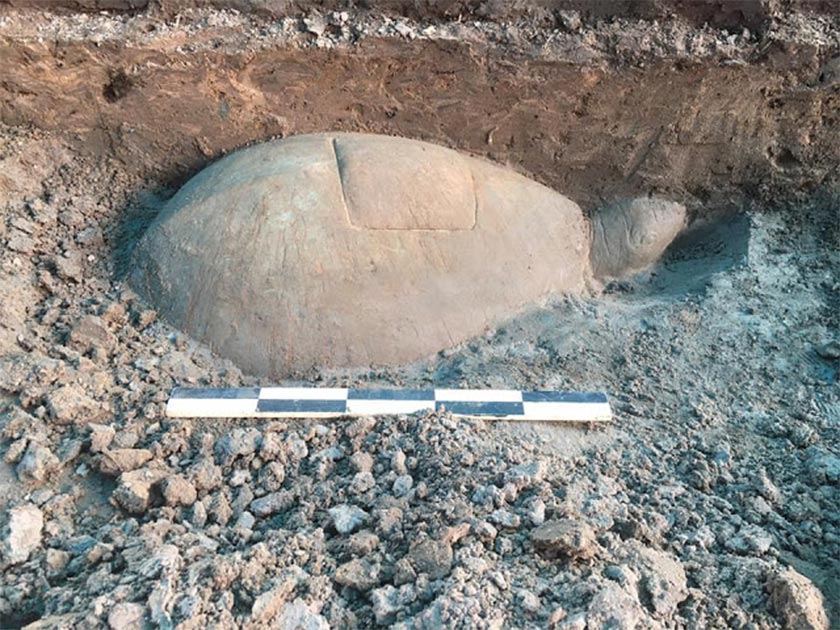Archaeologists in Cambodia have discovered a massive, century-old turtle statue in the temple complex of Angkor.

 The Srah Srang reservoir site at sunset, Angkor Archaeological Park, Cambodia.
The Srah Srang reservoir site at sunset, Angkor Archaeological Park, Cambodia.
On Wednesday, a carved, 56 by 93 centimeters (22-by-37 inches) carved stone turtle believed to date from the 10th century was discovered during digging at what was the site of a small temple that had been built on Srah Srang, one of Angkor’s several reservoirs.
Researchers pinpointed where the temple had been and workers drained the water off to enable the dig, which began March 16, said Mao Sokny, head of the excavation team of the Apsara Authority, a government agency that oversees the Angkor archaeological site.
The bottom half of the turtle remained buried Thursday while preparations were being made to lift it out without damaging it.
Angkor was strongly influenced by Hindu culture, and as a result, when a temple or other important structure was built, sacred objects would often be buried in the ground underneath as a gesture to ensure safety and good fortune.
In several Asian cultures, turtles are seen as symbols of longevity and prosperity.
 The turtle sculpture found in the Angkor reservoir is believed to have been placed as an offering in the temple’s foundation.
The turtle sculpture found in the Angkor reservoir is believed to have been placed as an offering in the temple’s foundation.
The Glories of a Temple Submerged in the Angkor Reservoir
According to The Star, ‘the remnants of the temple can be seen peeking over the waterline in the dry season’. Srah Srang is completely submerged during Cambodia’s wet season.
It appears that at some date the artificial island upon which the structure was built sank into the sediment of the Angkor reservoir or baray.
This temple is believed to date to the 9th or 10th century AD and was rebuilt by King Jayavarman VII.
It was built in the Khmer style of architecture that was influenced by South Indian buildings.
Some of the original landing points that were built to allow people to access the temple can still be seen. Archaeologists have unearthed a burial site with the cremated remains of many individuals near the sunken temple.
The Kandal Srah Srang temple was once one of the many wonders of Angkor Wat. Angkor Wat was the capital of the Khmer Empire, which was the dominant power in South East Asia for much of the Medieval era.
It was an Indianized kingdom and was heavily influenced by Buddhism and Hinduism. This Empire collapsed in the 15th century because of environmental factors and foreign invasions.
A Glimpse into Khmer Rituals and Ceremonies
The Hindu-Buddhist culture of the Khmer Empire is crucial in helping experts to understand the turtle statue. Similar objects have been found at Khmer temples such as Lor Ley, but the one found at Sran Srang is much larger.
Chea Socheat told The Khmer Times that “The turtle is known as one of the avatars of the Hindu god, Vishnu.” Depictions of turtles were often ritual offerings and they were placed in the center or foundations of temples.
However, experts cannot definitively state if this was the case for this particular statue, though they believe the sculpture may have been used as part of some religious ritual or celebration.
The Khmer Times quotes Chea Socheat as saying that “Our recent discovery can help explain the history of the temple, including the religious ceremonies that were once performed here.”
There have been many archaeological studies of the site but there have been no systematic investigations based on the objects unearthed.
 Trident found at Kandal Srah Srang Temple in Siem Reap province.
Trident found at Kandal Srah Srang Temple in Siem Reap province.
Thus, this rare find in the Angkor reservoir could help experts to better understand the culture and religion of the Khmer Empire.
Source:archaeology-world.com








